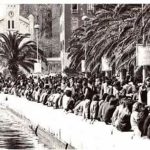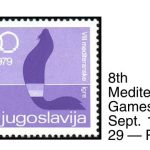A look at Bajamonti fountain in history with the help of Facebook group Split kroz povijest.
In the intersection between Prokurative and Palace Bajamonti, a monumental fountain was erected as a visible memorial to the reconstruction of Diocletian’s Waterway in 1880. The brainchild of the idea was the then Split chief Antonio Bajamonti. Based on Bajamonti’s ideas, Milanese sculptor Luigi Ceccona made a small plaster model of the fountain. Shortly after, Split engineer Jakov Antonelli and painter Josip Voltolini made a model of the fountain of natural size from wood and cardboard. Once it was complete, they placed it at the bottom of the Riva in this very location.
A special committee of citizens organized a meeting to collect funds for the fountain. In the newspapers, lists were published with the names and surnames of the donors and how much they contributed. There were 1322 donors in total (including various groups, and ecclesiastical and social communities) who participated in the quarterly collection of contributions. It is assumed that there were more than 2,000 donors (individuals and groups), and the actual number of donors was around 12,000 – almost the entire city of Split. Contributions were given not only by the people of Split but from donors from other cities and regions as well.
The excavations for the base of the fountain began at the end of February 1880. The design was commissioned at the Dell ‘Ara’s Stone Milling Workshop. In September of that year, the fountain was raised at its full height. However, due to the many litigations of Bajamonti and the Municipality, it was solemnly opened ten years later.
On December 15, 1888, water was released into the fountain and alas, she finally worked. Regardless of party intolerance, Gajo Bulat made a solemn opening of the fountain, thanking Bajamonti for his great share. On this occasion, they buried a galvanized tube that contained the third copy of the founding document from the mayor and representative of Dalmatian Parliament, Gajo Bulat, whom Bajamonti handed the keys over to for the underground space of the fountain. Bajamonti then held a speech in which he explained the symbolic meaning of the fountain and its figures.
The upper shell of the fountain where the water falls was symbolized by the Solin basin, which is affected by the river Jadro. The lower shell shows the Adriatic Sea, where dolphins are swimming with sea horses and sirens, Triton and Nereid. The masks that smoke symbolizes the four main winds on the Adriatic. On the upper part, there are four small geniuses representing Civilization, Power of Will, Trade and Craft (Industry). There is also a coat of arms of the Split municipality with a memorial sign. At the very top is the figure of the young man, the genius that represents his love for the homeland.
The fountain was later destroyed in 1947 by city authorities as a symbol of “fascism and Italian occupation.”









